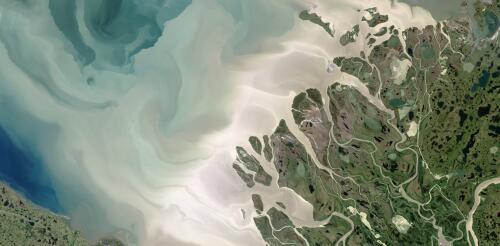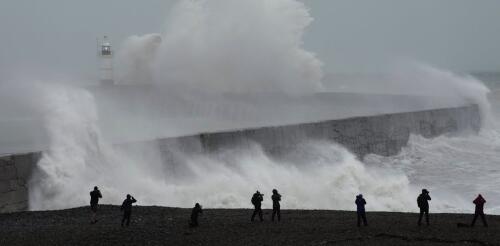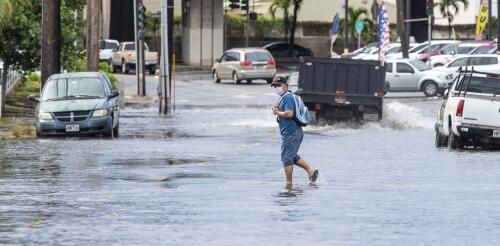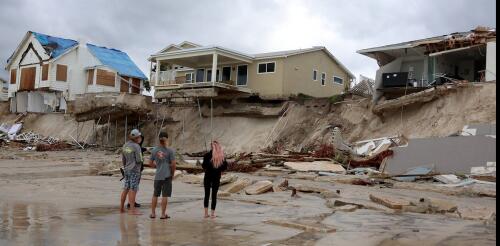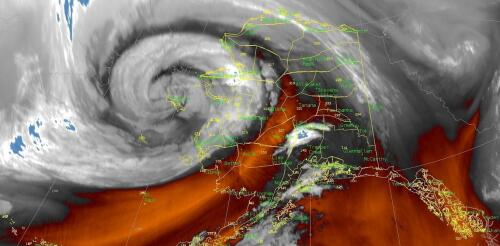Erosion
As the Arctic warms, its mighty rivers are changing in ways that could have vast consequences – not only for the Arctic region but for the world. Rivers represent the land branch of the earth’s hydrological cycle. As rain and snow fall, rivers transport freshwater runoff along with dissolved organic and particulate materials, including carbon, to coastal areas. With the Arctic now warming nearly four times faster than the rest of the world, the region is seeing more precipitation and the permafrost is thawing, leading to stronger river flows. Major river basins of the Arctic region. NOAA Arctic Report Card We’re climate scientists who study how warming is influencing the water cycle and ecosystems. In a new study using historical data and sophisticated computer models of Earth’s climate and hydrology, we explored how climate change is altering Arctic rivers. We found that th...
As oceans waves rise and fall, they apply forces to the sea floor below and generate seismic waves. These seismic waves are so powerful and widespread that they show up as a steady thrum on seismographs, the same instruments used to monitor and study earthquakes. That wave signal has been getting more intense in recent decades, reflecting increasingly stormy seas and higher ocean swell. In a new study in the journal Nature Communications, colleagues and I tracked that increase around the world over the past four decades. These global data, along with other ocean, satellite and regional seismic studies, show a decadeslong increase in wave energy that coincides with increasing storminess attributed to rising global temperatures. What seismology has to do with ocean waves Global seismographic networks are best known for monitoring and studying earthquakes and for allowing scientists to create images of the planet’s deep interior. These highly sensitive instruments continu...
Honolulu has lost more than 5 miles of its famous beaches to sea level rise and storm surges. Sunny-day flooding during high tides makes many city roads impassable, and water mains for the public drinking water system are corroding from saltwater because of sea level rise. The damage has left the city and county spending millions of dollars on repairs and infrastructure to try to adapt to the rising risks. Future costs will almost certainly be higher. More than US$19 billion in property value, at today’s dollars, is at risk by 2100 from projected sea level rise, driven by greenhouse gas emissions largely from the burning of fossil fuels. Elsewhere in Honolulu County, which covers all of Oahu, many coastal communities will be cut off or uninhabitable. Unwilling to have their taxpayers bear the full brunt of these costs, the city and county sued Sunoco LP, Exxon Mobil Corp. and other big oil companies in 2020. Their case – one of more than two dozen involving U.S. ci...
Back-to-back hurricanes left an unnerving scene on the Florida coast in November 2022: Several houses, and even swimming pools, were left dangling over the ocean as waves eroded the property beneath them. Dozens of homes and condo buildings in the Daytona Beach area were deemed unsafe. The destruction has raised a disturbing question: How much property along the rest of the Florida coast is at risk of collapse, and can it be saved? As the director of iAdapt, the International Center for Adaptation Planning and Design at the University of Florida, I have been studying climate adaptation issues for the last two decades to help answer these questions. Drone footage shows homes close to collapsing into the ocean. WPLG/YouTube. Rising seas, aging buildings Living by the sea has a strong appeal in Florida – beautiful beaches, ocean views, and often pleasant breezes. However, there are also risks, and they are exacerbated by climate chang...
The powerful remnants of Typhoon Merbok pounded Alaska’s western coast on Sept. 17, 2022, pushing homes off their foundations and tearing apart protective berms as water flooded communities. Storms aren’t unusual here, but Merbok built up over unusually warm water. Its waves reached 50 feet over the Bering Sea, and its storm surge sent water levels into communities at near record highs along with near hurricane-force winds. Merbok also hit during the fall subsistence harvest season, when the region’s Indigenous communities are stocking up food for the winter. Rick Thoman, a climate scientist at the University of Alaska Fairbanks, explained why the storm was unusual and the impact it’s having on coastal Alaskans. What stands out the most about this storm? It isn’t unusual for typhoons to affect some portion of Alaska, typically in the fall, but Merbok was different. It formed in a part of the Pacific, far east of Japan, where historically few ty...
